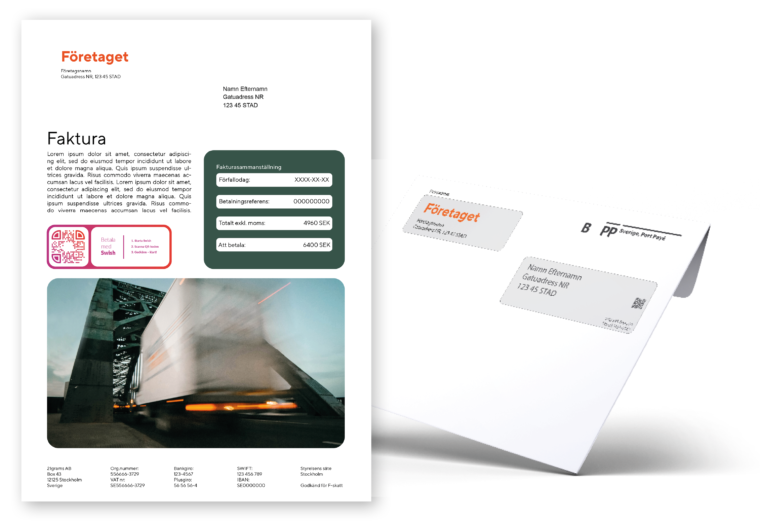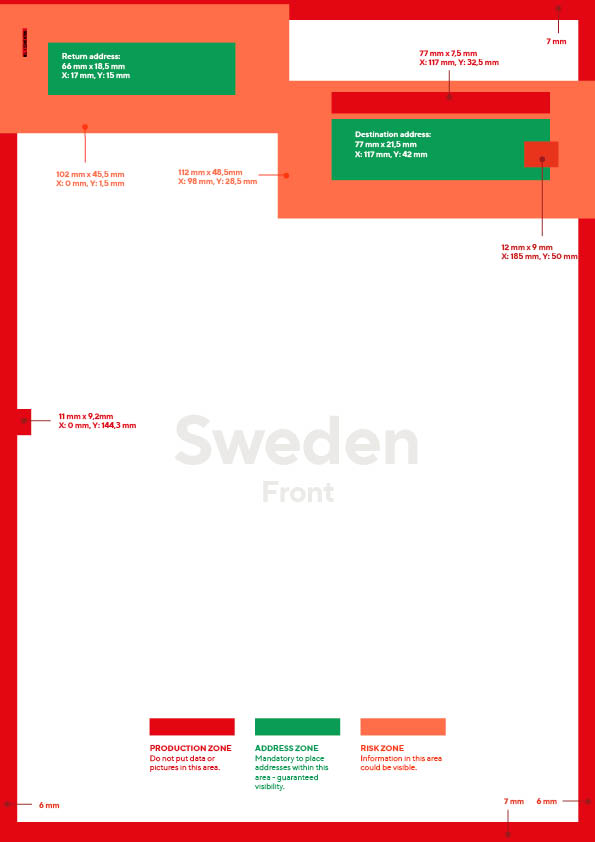iMail - Sweden

Example iMail print
iMail template
Production zone
This space is allocated for the print production and needs to be cleared from any data or pictures.
Address zone
This space indicate the optimal area of placement for bot the address of the sender, but also for the receiver. If the address is positioned as close to the marked area the information is garanteed to be visible.
Risk zone
Everything within this marked zone are at risk for being displayed in the windows.
Customer shipment ID at PostNord (Kundsändningsprofil)
If you have a Customer shipment ID (Kundsändningsprofil) at PostNord you need to take into account that a ID number will be placed at X: 12mm and Y: 8mm with the dimension 3mm x 27mm in the return address window. This area is not included in the PDF template since not all customers have this service.


PDF format restrictions
Technical specification – in short
- File size max 3 Mb
- Format, A4, 210×297 mm, no bleed
- Color model, CMYK
- Fonts, except BASE14 fonts, should be embedded in whole where possible
- Transparency shall be avoided at all times
- Vector images, Complex version of EPS, AI or SVG should be avoided at all times
- Vector gradients, should be avoided at all times
- PDF/A and PDF/X1a is supported
Envelope
The iMail service provides print mailings in neutral white envelopes with two windows. Here follows information about the envelopes.
Envelope types:
C5: contains max. 8 sheets (equivalent to 8 simplex pages or 16 duplex pages).
C4: contains max. 40 sheets (equivalent to 40 simplex pages or 80 duplex pages).
Envelope design:
1. PPI (post paye indicia)
2. Window for destination address
3. Window for return to sender address
4. Official sender

How to address in Sweden
Domestic letters
1. Cliché & Port payé
– All letters submitted in Sweden are marked with “Port payé”.
– For Economy mail and ADRs, the envelopes are also marked with a B.
2. Destination address
– Must contain a correct Swedish address – nothing else can be visible in the window.
– Country is not to be added (Sverige/Sweden/SE)
– There can not be any text, numbers or markings that do not belong to the address in the address window
– Approved fonts: Arial (sans serif), Verdana, Courier & Times New Romana
– Use font size 10-12 points
– Use a straight left margin
– Do not use blank lines
– Line spacing should be 1 or 1.5. All lines must have the same line spacing
– No empty lines in the address, nor empty lines containing junk characters
– Both recipient window and return window must have a white background and contain only address information.
3. Return address
– A return adress is mandatory.
– The return address must be a Swedish address.
4. Sender
– The sender is the person who pays the postage to the distributor and must always be indicated on the shipment
– The sender must always be indicated with full name and postal address and preceded by “From: “

Foreign letters
1-2. Destination address
– Must contain a complete address including the name of the country in Swedish and/or English.
– If there is a postal code – you can use a standardized country code as a prefix with a hyphen in front
3. Return address
– A return adress is mandatory.
– The return address must be a Swedish address.
Foreign clichés & Port payé
For operators other than PostNord, other requirements for evidence and postage-paid stamps may apply.

Post operator zones
This applies to letters that are machine-processed by the respective postal operator.
1. PostNord
Always leave a zone in the lower right corner of 150 x 30 mm free for printing sorting codes.
2. Citymail & Morgonpost
Always leave a zone at the top edge of 150 x 10 mm
3. Citymail & Morgonpost
Always leave a free zone on the flap of the letter for 150 x 15 mm

Example of how the post operator zones are used




Free zon
Around the address there must be a free zone of at least 5 mm, preferably 15 mm, for machine interpretation of the address to work.

Codes for sorting the letters
1. Sort codes from 21grams
To facilitate the production of letters, these codes exist:
– 01, pallet number
– 03, bundle and box number
– (1), document number
*** break between bundles & boxes
2. Example sorting code for PostNord
3. Example sorting code for Citymail
4. Example sorting code for Morgonpost
All operators always (or in some cases only for larger shipments) use sorting codes to facilitate the work of sorting letters. All codes are of different lengths and it is important that the entire code is legible for the distributor.
The rule of a free zone around the address also applies to the codes.

